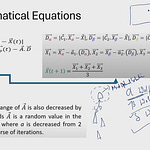Whenever you're ready, here are three great ways you can support us:
Promote yourself or your organisation by sponsoring this newsletter — we reach an engaged audience with a 30–40% weekly open rate. Please leave a message or contact me directly at mrinmoy@majumdar.info.
Upgrade to a paid membership and unlock exclusive insights and benefits. Click here. (Click here to pay in USD)
Subscribe to the “AIDS in WRD” Podcast on YouTube and stay connected with the latest in the application of AI and DS in water resource research. Click here.
Linear Programming: Optimizing Solutions with Mathematical Precision
Linear programming (LP) is a powerful mathematical technique used to identify the best possible outcome—such as maximum profit or minimum cost—within a set of linear relationships and constraints. This method is foundational in various fields including business, economics, engineering, and operations research, aiding in optimal decision-making and resource allocation.
Core Concepts of Linear Programming
At its heart, linear programming involves maximizing or minimizing a linear objective function subject to a series of linear constraints. These constraints represent limitations or requirements that must be met in real-world problems, such as resource capacity, time, or budget restrictions. The objective function expresses the goal, like maximizing profits or minimizing costs, and is represented mathematically with decision variables that are adjusted to find the optimal solution.
Key Components
Decision Variables: Quantities that can be controlled or decided upon to achieve the optimization goal.
Objective Function: A linear function defining the goal of maximization or minimization.
Constraints: Linear equations or inequalities that delineate the feasible region where the solutions must lie.
Non-negativity Restrictions: Conditions ensuring that decision variables take on realistic, non-negative values.
Applications and Importance
Linear programming's applications are widespread, from determining production levels in manufacturing, optimizing transportation routes, managing portfolios in finance, to resource allocation in telecommunications. Its linearity makes it mathematically tractable, allowing efficient algorithms like the Simplex method and graphical methods for solving problems. By converting complex scenarios into linear models, LP enables clearer insights and practical solutions for complex decision-making.
In summary, linear programming is an indispensable optimization tool that provides structured, efficient ways to handle constraints and make the best possible decisions in a variety of practical contexts, ultimately enhancing productivity and profitability across disciplines.
Subscribe to my YouTube Channel for the full video or become a paid member of Baipatra VSC Newsletters
Contribute to this newsletter.
You may also like :
1)Explore Lenovo(AD)
4)International Journal of HydroClimatic Engineering: Call for Paper
5)Virtual Forum on Water and Power Engineering: Call for Paper
7)Bio Inspired Optimization Technique Bundle Membership
8)How to open your own home page?(AD)
9)Podcast : Hydrology for Beginners









